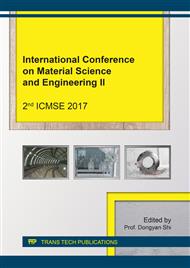[1]
K. Rajashekara, and A. K. Rathore, Power Conversion and Control for Fuel Cell Systems in Transportation and Stationary Power Generation. Electr. Power Comp. Syst. 43(12) (2015) 1376-1387.
DOI: 10.1080/15325008.2015.1034383
Google Scholar
[2]
L. Li et, al. Enhanced stability of Pt nanoparticle electrocatalysts for fuel cells, J. Nano Res. 8(2) (2015) 418-440.
DOI: 10.1007/s12274-014-0695-5
Google Scholar
[3]
J. Meier, et, al. Degradation mechanisms of Pt/C fuel cell catalysts under simulated start–stop conditions. ACS Catal. 2 (2012) 832–843.
DOI: 10.1021/cs300024h
Google Scholar
[4]
Y. J. Wang et al. Noncarbon Support Materials for Polymer Electrolyte Membrane Fel Cell Electrocatalysts. J. Chem. Rev. 111 (2011) 7625-7651.
DOI: 10.1021/cr100060r
Google Scholar
[5]
D. Reyes-Coronado et al. Phase-pure TiO2 nanoparticles: anatase, brookite and rutile. J. Nanotech. 19 (2008) 145605.
DOI: 10.1088/0957-4484/19/14/145605
Google Scholar
[6]
K. W. Park, K. S. Seol. Nb-TiO2 supported Pt cathode catalysts for polymer electrolyte membrane fuel cells. Electrochem. Commum. 9 (2007) 2256.
DOI: 10.1016/j.elecom.2007.06.027
Google Scholar
[7]
V. T. T. Ho et al. Nanostructured Ti0, 7Mo0, 3O2 Support Enhances Electron Transfer to Pt: High-Performance Catalysts for Oxygen Reduction Reaction. J. Am. Chem. Soc. 133 (2011) 11716-11724.
DOI: 10.1021/ja2039562
Google Scholar
[8]
M. A. Butler. Photoelectrolysis and physical properties of the semiconducting electrode WO2, J. Appl. Phys. 48 (1977) (1914).
Google Scholar
[9]
F. Micoud et al. Unique CO-tolerance of Pt-WOx materials. J. Electrochem. Commun. 11 (2009) 651 – 654.
DOI: 10.1016/j.elecom.2009.01.007
Google Scholar
[10]
V. Raghuveer, B. Viswanathan. Synthesis, characterization and electrochemical studies of Ti-incorporated tungsten trioxides as platinum support for methanol oxdation. J. Power Sour. 144 (2005) 1–10.
DOI: 10.1016/j.jpowsour.2004.11.033
Google Scholar
[11]
D. Wang et al. Highly Stable and CO-Tolerant Pt/Ti0, 7W0, 3O2 Electrocatalyst forr Proton-Exchange Membrane Fuel Cells. J. Am. Chem. Soc. 132(30) (2010) 10218–10220.
DOI: 10.1021/ja102931d
Google Scholar
[12]
Y. Xiao et al. W-doped TiO2 mesoporous electron transport layer for efficient hole transport material free perovoskite solar cells employing carbon counter electrodes. J. Power Sour. 342 (2017) 489–494.
DOI: 10.1016/j.jpowsour.2016.12.079
Google Scholar
[13]
W. Sangkhun et al. Photocatalytic degradation of BTEX using W-doped TiO2 immobilized on fiberglass cloth under visbile light. J. Superlattices Microstruct. 52 (2012) 632–642.
DOI: 10.1016/j.spmi.2012.06.026
Google Scholar
[14]
K. Nishio, S. Tadanori, and T. Tsuchiya, Preparation of Electrochromic Tungsten Oxide Thin Film by Sol-Gel Process. Ceram. Soc. Japan, 107 (1999) 199-203.
DOI: 10.2109/jcersj.107.199
Google Scholar
[15]
Y. Yang et al. Electrospun mesoporous W6+-doped TiO2 thin films for efficient visible-light photocatalysis. J. Mater. Lett. 63 (2009) 331–333.
DOI: 10.1016/j.matlet.2008.10.037
Google Scholar
[16]
X. Zhang et al. Dye-Sensitized W-Doped TiO2 Solar Cells with a Tunable Conduction Band and Supperessed Charge Recombination., J. Phys. Chem. C, 115 (2011) 12665–12671.
DOI: 10.1021/jp201853c
Google Scholar
[17]
S. Sathasivam, et al., Tungsten Doped TiO2 with Enhanced Photocatalytic and Optoelectrical Properties via Aerosol Assisted Chemical Vapor Deposition. Sci. Rep. 5 (2015) 10952.
DOI: 10.1038/srep10952
Google Scholar


